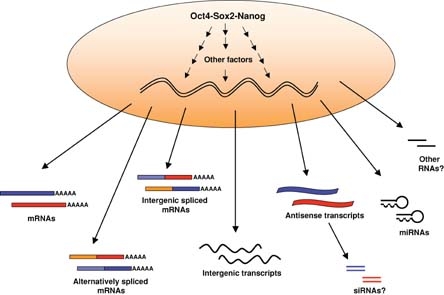
This web page was produced as an assignment for an undergraduate course at Davidson College.

The transcriptome of a pluripotent cell. Image from Wiki Commons
A transcriptome refers to the full set of all transcripts of RNA molecules in a single cell, tissue type or organism at any given time. The transcriptome is derived from a small percentage of the genome transcribed into RNA molecules. In humans, the transcript percent is less than 5% (Adam 2008). The transcripts take up the intermediate step between genes and proteins, but includes non-coding RNA (ncRNA) such as transfer RNA (tRNA) and ribosmal RNA (rRNA) as well.
Unlike the stable genome, transcriptomes are fairly dynamic and actively changing due to many factors such as external environmental conditions. As a precursor to proteomes, transcriptomes can help piece together the gap between the genetic code and the functional molecules of a cell. Because transcriptomes are comprised of RNA molecules, including mRNA, the transcripts can be measured quantitatively to infer different types of gene expression levels or activity from a single cell. Thus, transcriptomics plays an important role in painting the complex picture of the cellular mechanism and functional genomics.
Traditionally, microarrays are used to examine the transcriptome for their cost-effectiveness and means to compare mRNA levels. Recently, advances in next generation RNA sequencing technology (RNA-Seq) has allowed a more direct way of measuring an entire transcriptome at the nucleotide level, adding to our knowledge of the complexity of the transcriptome. RNA-seq is emerging to be the preferred analysis method. Another student webpage on RNA-seq can be found here.
Single-cell transcriptome analysis methods. Adapted from Tang et al 2011
Transcriptomics is particularly useful in epidemiology studies, especially for research in cancer. Transcriptome indication of gene activity makes it particularly useful for research of the unique properties of stem cells in human development.
Adams, J. (2008) Transcriptome: connecting the genome to gene function. Nature Education 1(1):195http://www.nature.com/scitable/topicpage/transcriptome-connecting-the-genome-to-gene-function-605#
Tang, F., Lao, K., Surani, M. (2011) Development and applications of single-cell transcriptome analysis. Nature Methods 8. doi:10.1038/nmeth.1557
Genomics Page
Biology Home Page
© Copyright 2014 Department of Biology, Davidson College, Davidson, NC 28035